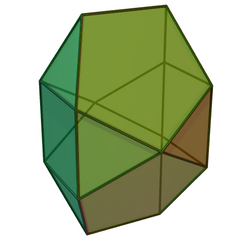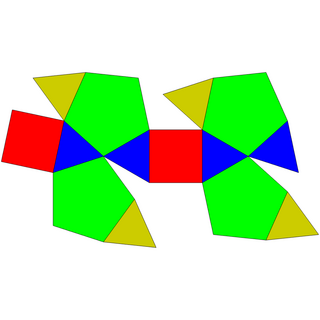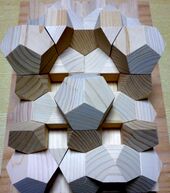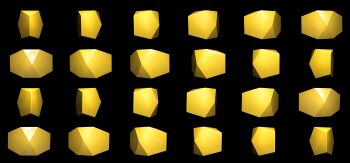Bilunabirotunda
| Bilunabirotunda | |
|---|---|
 | |
| Type | Johnson J90 – J91 – J92 |
| Faces | 2x4 triangles 2 squares 4 pentagons |
| Edges | 26 |
| Vertices | 14 |
| Vertex configuration | 4(3.52) 8(3.4.3.5) 2(3.5.3.5) |
| Symmetry group | D2h |
| Dual polyhedron | - |
| Properties | convex |
| Net | |
 | |
In geometry, the bilunabirotunda is one of the Johnson solids (J91). A Johnson solid is one of 92 strictly convex polyhedra that is composed of regular polygon faces but are not uniform polyhedra (that is, they are not Platonic solids, Archimedean solids, prisms, or antiprisms). They were named by Norman Johnson, who first listed these polyhedra in 1966.[1]
Geometry
It is one of the elementary Johnson solids, which do not arise from "cut and paste" manipulations of the Platonic and Archimedean solids.
However, it does have a strong relationship to the icosidodecahedron, an Archimedean solid. Either one of the two clusters of two pentagons and two triangles can be aligned with a congruent patch of faces on the icosidodecahedron. If two bilunabirotundae are aligned this way on opposite sides of the icosidodecahedron, then two vertices of the bilunabirotundae meet in the very center of the icosidodecahedron.
The other two clusters of faces of the bilunabirotunda, the lunes (each lune featuring two triangles adjacent to opposite sides of one square), can be aligned with a congruent patch of faces on the rhombicosidodecahedron. If two bilunabirotundae are aligned this way on opposite sides of the rhombicosidodecahedron, then a cube can be put between the bilunabirotundae at the very center of the rhombicosidodecahedron.
Each of the two pairs of adjacent pentagons (each pair of pentagons sharing an edge) can be aligned with the pentagonal faces of a metabidiminished icosahedron as well.
The bilunabirotunda has a weak relationship with the cuboctahedron, as it may be created by replacing four square faces of the cuboctahedron with pentagons.
Cartesian coordinates
The following define the vertices of a bilunabirotunda centered at the origin with edge length 1:
- [math]\displaystyle{ \left(0, 0, \pm\frac{\varphi}{2}\right) }[/math]
- [math]\displaystyle{ \left(\pm\frac{\varphi+1}{2}, \pm\frac{1}{2}, 0\right) }[/math]
- [math]\displaystyle{ \left(\pm\frac{1}{2},\pm\frac{\varphi}{2},\pm\frac{1}{2}\right) }[/math]
where [math]\displaystyle{ \varphi=\frac{1+\sqrt{5}}{2} }[/math] is the golden ratio.
Related polyhedra and honeycombs
Six bilunabirotundae can be augmented around a cube with pyritohedral symmetry. B. M. Stewart labeled this six-bilunabirotunda model as 6J91(P4).[2]
The bilunabirotunda can be used with the regular dodecahedron and cube as a space-filling honeycomb.

|
 Spacefilling honeycomb |
 6 bilunabirotundae around a cube |
File:3D space tessellation of cubes and dodecahedra.ogg 12 bilunabirotundae around a dodecahedron |
External links
- ↑ Johnson, Norman W. (1966), "Convex polyhedra with regular faces", Canadian Journal of Mathematics 18: 169–200, doi:10.4153/cjm-1966-021-8.
- ↑ B. M. Stewart, Adventures Among the Toroids: A Study of Quasi-Convex, Aplanar, Tunneled Orientable Polyhedra of Positive Genus Having Regular Faces With Disjoint Interiors (1980) ISBN:978-0686119364, (page 127, 2nd ed.) polyhedron 6J91(P4).
- Eric W. Weisstein, Bilunabirotunda (Johnson solid) at MathWorld.
- Miracle Spacefilling (Dodecahedron&Cube&Johnson solid No.91)
 |


